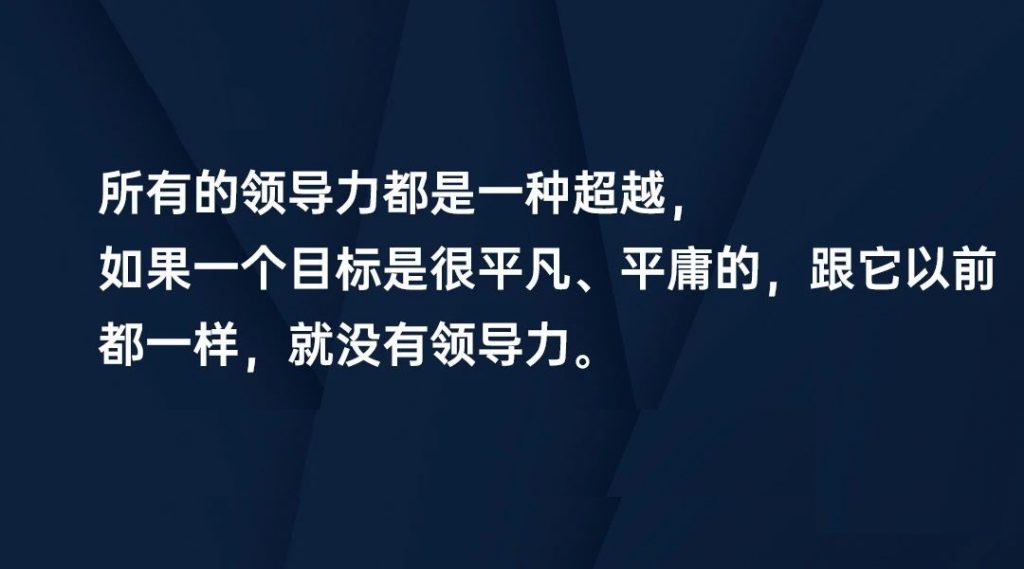
3 levels of leadership, let others follow voluntarily!
Guide: Leadership has three levels of architecture: The outermost layer: follow him to have meat to eat, follow him to win; Middle layer: follow him to have a sense of participation and belonging, and grow together; Core layer: We fight for what we value in common. This article will tell you why people want to follow you – the “genetic” model of leadership.
.
There is a question that makes us ponder:
What are the essential elements of being a good leader?
Or, why do people want to follow you?
In Chinese culture, there is a fairly common and romantic answer to this question:
Because the leader has “aura”. But what is this mysterious and confusing “aura”? People’s answers are varied, such as attractiveness, personality, influence, reputation, etc., to name a few.
.

Because the leader has “aura”. But what is this mysterious and confusing “aura”? People’s answers are varied, such as attractiveness, personality, influence, reputation, etc., to name a few.
First, let’s talk about what leadership is.
I just interviewed a CEO yesterday. The company has been in business for less than two years and has developed very fast. In the past two years, the performance growth rate has been between 50% and 80% every year. The team has grown rapidly while the performance has grown rapidly. At this time, human problems will naturally come to the fore.
This CEO shared with me:

“Actually, in such a market in China, what I lack is not money, nor opportunities, nor are some very good ideas, some ideas and so-called business models.
Because a lot of people already have these things.
What I lack the most is talent. “
The CEO continued: “If I am given the right talent, I am very confident that the company’s performance will be 3 to 5 times higher than it is now.”
Therefore, in the final analysis, it is still a matter of people. Everyone understands and agrees with this principle.
Some people say that talent is the capital of our company.
Many companies call human resources Human Capital.
However, I say NO.
Talent is not your capital, only those who are motivated and can work together in the same direction as you are your capital.
Therefore, the core issue of talent is the issue of leadership.
In one sense, leadership is a matter of motivating talent.
The core problem of talent management is the leadership of managing these talents.

So, what is leadership?
In our Chinese culture, there is a very interesting saying: the reason why a leader has leadership is because he has a “gas field”.
This “aura” sounds very interesting and romantic, such a mysterious thing; but it sounds confusing, where does this aura come from?
Many people have tried to get to the root of this problem. To get to the bottom of it, the answer may be varied.
Leadership is nothing more than answering a question: Why are your followers following you?
So, for a while, I would ask this question every time: Why do you think those subordinates should follow you? Why are they able to follow you so hard to try and work for a long time? What is the reason?
Therefore, from these answers, we have also obtained some common and similar answers. We summarize these things and scrutinize them repeatedly to form a definition of leadership, which is also shared with you here.
In a word, leadership is about how to motivate followers to surpass themselves and achieve higher goals together, and it is also a relationship between leaders and followers.
.

4 Key Elements of Leadership
The first point, leadership is the ability to motivate others, which is different from management. The second point, what motivates them to do? In fact, all leadership is a kind of transcendence, to achieve a kind of transcendence.
Therefore, the followers you inspire, want to go beyond a goal, or achieve a lofty and grand goal; If this goal is very ordinary and mediocre, it is the same as before, and if it is not surpassed, there will be no leadership. For example, this group of people, if they do this year, they will do the same next year. This year they will achieve the goal of 10 million, next year it will be 10 million, and the year after that will be 7 million. This does not have leadership, so leadership is a kind of transcendence.
Transcendence means to achieve a higher goal. Transcendence can be beyond oneself, beyond others, or beyond the surroundings.
The so-called higher goals may be all kinds of higher, and it may be higher in scale.
For example, if you now achieve a business target of 10 million, it will become 12 million next year, and 15 million the year after, which is of course a kind of transcendence, or higher; But it may also be the transcendence of another target, such as higher profits under the same target.

It may also be a product innovation. As everyone sees, Apple is achieving some transcendence every year, whether it comes from itself or from the pressure of the market, every new Apple mobile phone is released, and everyone is in Looking forward to it having some product innovations, some revolutionary things appear. It is also a transcendence.
This transcendence can be compared with others or with yourself.
In any case, this kind of transcendence is a very important motivation that can motivate everyone to work together.
The third point, it must be to achieve this goal together, it must be a group of people under your inspiration, everyone can achieve this goal together.
Rather than any individual, let alone the leader achieving his own goals, everyone else is watching the leader work hard like a circus.
Therefore, jointly accomplishing this transcendence is also an essential characteristic of leadership.
If there is no commonality, it is not leadership. Even if you run fast in front, but when you look back and no one is following behind, it is not motivation.
The fourth point is that leadership is an interpersonal relationship between a leader and followers, which is actually similar to other human relationships.
These interpersonal relationships change from time to time and from person to person. It is a dynamic relationship, not static.
Therefore, this meaning, in terms of leadership, means that leadership has a kind of stickiness and adhesion to a group of followers, which does not mean that it has the same stickiness and adhesion to other people.
When a leader jumps to another company or changes a group, he has to re-establish a stickiness with his new followers.
Therefore, he has to start all over again, even if the leader and his same group of followers had strong leadership last year, it does not mean that you will have strong leadership next year, because everything is changing, others followed you last year, not Equal to next year will follow you.
Therefore, the leader needs to maintain and maintain such a relationship, such a stickiness, between him and his followers. This is also an inherent characteristic of leadership. These cannot be taken for granted. What was good in the past will be good in the future. You have leadership for some people, but you may not have leadership for another group of people.
.

3 levels of leadership
We believe that leadership actually talks about why others should follow you and why others are willing to follow you.
To answer such a question, there are various answers, but it can be summed up in three aspects:

The first level, leading the business
Others are chasing you and following you because they have meat to eat with you. What does it mean to have meat to eat? Just follow such an excellent leader, with performance, results, and results, everyone follows him to be a successful team, from victory to victory.
At this level, we need to consider whether the leader can lead everyone to go beyond and achieve business goals. This level is very important, this is the first level.
The second level, leading others
Others follow you because following you will give you a sense of belonging, because following your team, everyone is doing something very meaningful together, and such a team is sticky.
As you can imagine, when your employees want to leave you, they will be very reluctant. When you want to leave your employees, you will be reluctant as a leader. This is a sense of belonging, and it is a pity to give up this sense of belonging.
Therefore, on the second level, the existence of leadership is due to the interpersonal relationship established between people, the stickiness between people.
The third level, leadership values
It is the resonance of values, we call it leadership values. Why do others follow you to fight, why work so hard? The most rooted and core thing is that everyone is doing something that everyone thinks is very important.
These things are meaningful to you, and they are also very meaningful to me. They are things that you are unwilling to give up and cannot be compromised. Therefore, everyone has common values to come together. This is called the resonance of values.
.

4 elements of leadership
In fact, being a leader has some very important characteristics. When others follow you, the first reason is that they don’t know where to go; You know where you are going, you know where your direction is, and you know where the future is.
Maybe you don’t have a 100% answer, but you know more than him, and you have a better sense of direction, so he follows you.
If you don’t know what to do yourself, how can others follow you? So, leaders need to be more visionary than everyone else and know where to go.
This direction may be the direction of the team, the direction of the company, or the direction of the industry. He must grasp the general trend and know not only today and tomorrow, but also the longer-term future. We call it visionary.

Second, knowing the future direction, you must be able to realize it, which is the so-called executive power.
A good leader also needs to be able to realize this dream. He needs to not only stand tall and see far, but also be able to accomplish his established goals down-to-earth, lead everyone forward step by step, and achieve their goals together.
So execution, or efficient execution, is also an indispensable element of leadership.
Third, we say that leadership is to lead everyone to achieve transcendence. This transcendence, whether transcending oneself or transcending the surroundings, since it is transcendence, it must not be easy.
If you lead a group of people to climb Mount Everest, it will definitely not be as simple as climbing Xiangshan. In the process of achieving difficult goals, there are bound to be many obstacles and difficulties.
Therefore, it is only natural and inevitable for leaders to encounter difficulties and obstacles.
In the face of difficulties, excellent leaders have an indispensable characteristic, that is, they are tenacious, they can persevere, they are not easily abandoned when encountering difficulties, and they can firmly believe in their goals.
Fourth, we are now in a rapidly changing, ambiguous, poorly defined, and complex environment. In such an environment, it is easier to change, and it is difficult to ponder the business changes in the past few decades.
Therefore, a good leader must be alert and know when to change, when to innovate, and when to turn around and turn.
We can see that although there are only four elements, it is not easy to achieve them at all. It is not easy for a good leader to do well in it.
It all sounds contradictory, foresight and efficient execution, foresight you need to be able to dream, to be able to stand high, to see far. Efficient execution requires him to see today and see how he will live tomorrow.
So, Jack Welch has a very well written and very straightforward article, good leaders have to eat, but also to dream.
It is a contradiction to be down-to-earth to ensure that our performance in front of us can be achieved, and at the same time to know where the future direction is and to have our own dreams.
The second pair of contradictions is the tenacity mentioned just now, and the inability to give up when encountering difficulties and setbacks.
Everyone knows such a story. In the process of digging gold, 9999 picks were dug, and until the last pick was not dug, no gold was found, but if you persist, you will be finished. This is perseverance.
But if the direction is wrong, you persist, the worse you persist.
So when should we persist and when should we change? Where is the answer?
There is no answer, this is a pair of contradictions, so being able to achieve business goals means that a balance must be reached between the two pairs of contradictions.
One is standing tall, the other is seeing far; the other is tenacity, and the other is quick response.
These two contradictions are difficult to balance.
We would like to quote a Chinese theory of yin and yang gossip here, the so-called farsightedness means standing tall and seeing far, like the sun, it can stand very high and shine far;
And down-to-earth, very persistent like the earth.
Therefore, there is one sky and one earth, and in the yin and yang, there is one yang and one yin.
Perseverance is a very strong willpower, it is a rigid, agile response, and a soft body; so a rigid, a soft, is also a yang, a yin.
This is an interesting combination of two pairs of Yin Yang.
If you can achieve a balance artistically at any time on the yin and yang combination of these two pairs, just like you are on the balance beam, you will be an excellent leader.
Here, we see that leadership is an art with no standard answer. Others have done a good job in some aspects. If you simply copy it, it may not be possible. Because everything changes because of time, place, and people.
With regard to human issues, we summarize these aspects into three key points, which are building relationships, motivating participation, and cultivating talents.
From establishment to motivation to cultivation, we can use a simple English name called RED to make it easy to remember.
.
1) Establish a relationship Relation
Building relationships is both internal and external.
A few years ago I interviewed Liu Chuanzhi, one of our excellent leaders in China, and he had a vivid metaphor:
A leader is a thread, and the people around him are pearls. An important role of a leader is to string the pearls together.
To establish such a relationship, in fact, the role of the leader is to be able to put together various internal and external resources, string them together, and then everyone can achieve a common goal.
So, building relationships is clearly an essential element of leadership.
.
2) Incentive to participate in Excitation
Because we just said that the definition of leadership is to motivate everyone to achieve a goal together. Therefore, only by encouraging everyone to participate and do together can we have leadership. Rather than just a handful of people doing it there.
.
3) Cultivating talents Develop
The importance of developing people has been raised so high that some even regard it as the only definition of leadership.
Cultivating talents is of course very important, but cultivating talents is a long-term matter, so it does not necessarily need to be raised to that level alone.
.
4) Resonance of values
This is an element that we deeply understand. Going back to the core issue of leadership, it is why others are willing to follow you, fight with you, fight with you. The biggest and strongest reason is what we call values. resonance.
Only a stickiness at this level is the strongest stickiness of leadership.
I often cite stories that resonate with values.
For example, Song Jiang in “Water Margin”, such as Liu Bei, Liu Bang, etc., are their martial arts very strong?
no.
Are they good at platooning? Are you very strategic? Neither.
However, compared with the generals around him and his buddies, they have one difference, that is, they have very clear values, and their values guide them to achieve all kinds of transcendence.
In the past ten years, some people in the West have put forward a very good theory called True Self Leadership.
A good leader, in fact, can do well in three or four key aspects, and there are no obvious faults or obvious defects in other aspects. That is already very powerful.
.

What is “potential”?
For enterprises, when cultivating people, if they can select these people with high potential for training, it will naturally be a way to get twice the result with half the effort; so for the research on potential, this is a very important topic.
What we’re talking about here is the potential for leadership.
As mentioned earlier, leadership can inspire others to achieve common transcendence and achieve higher goals.
Then we can expand the potential of leadership into a person with excellent leadership potential. He has the possibility to inspire more followers, achieve transcendence together, and achieve higher goals. This is a possibility. kind of potential.
A person with leadership potential can often get higher and higher positions in a general organization, so that he can transcend his own functions and status and become a leader who affects the overall situation.
His own ability can be affected by the ability of one person to the ability of more people. This amplification is actually an improvement or growth of leadership.
In this way, what kind of people have higher leadership potential?
We see it in several ways:
.
1) Have a strong willingness to lead
He has the will to be a leader. Not everyone wants to be an official or a leader, because being a leader entails more responsibilities, pressure and more risks.
Not everyone is willing to bear such pressure, so the willingness of leadership is a fundamental element.
If we talk about the common characteristics of excellent leaders, if you study a hundred or a thousand leaders, each of them has different personalities and characteristics, and their abilities and experiences may be different, but They all have the will to lead.
Has a strong will to lead, which is a fundamental will, and it is not easy to change.

.
2) have relevant work experience
There are all kinds of work experience, and there are all kinds of life experiences, success, failure, pain, laughter.
In different occupations, functions, different geographical locations, in different life curves of enterprises or organizations, whether in the entrepreneurial stage or the mature stage, there are various experiences, as well as a good educational background, and some related experience, he has it all.
.
3) Learning acumen
He is a combination of special abilities, which actually enable these leaders to learn new things quickly in a rapidly changing environment.
When they have no experience and don’t know how to do it, they can learn quickly and apply what they learn to new or challenging leadership situations, and they can achieve great performance.
Such an ability, not just ability, but also a willingness of them.
Therefore, we can take the willingness just mentioned as a starting point, take relevant work experience as an external factor, and learning acumen is an internal factor for the growth of these leaders.
With these external factors, these opportunities, and these internal factors, he can quickly internalize what he has seen and learned into the establishment of some new abilities of his own. Step-by-step improvement of leadership.
Under the combined action of internal and external factors, the potential of leadership is released, which is a growth process of leadership. (end)
.

.
.
















